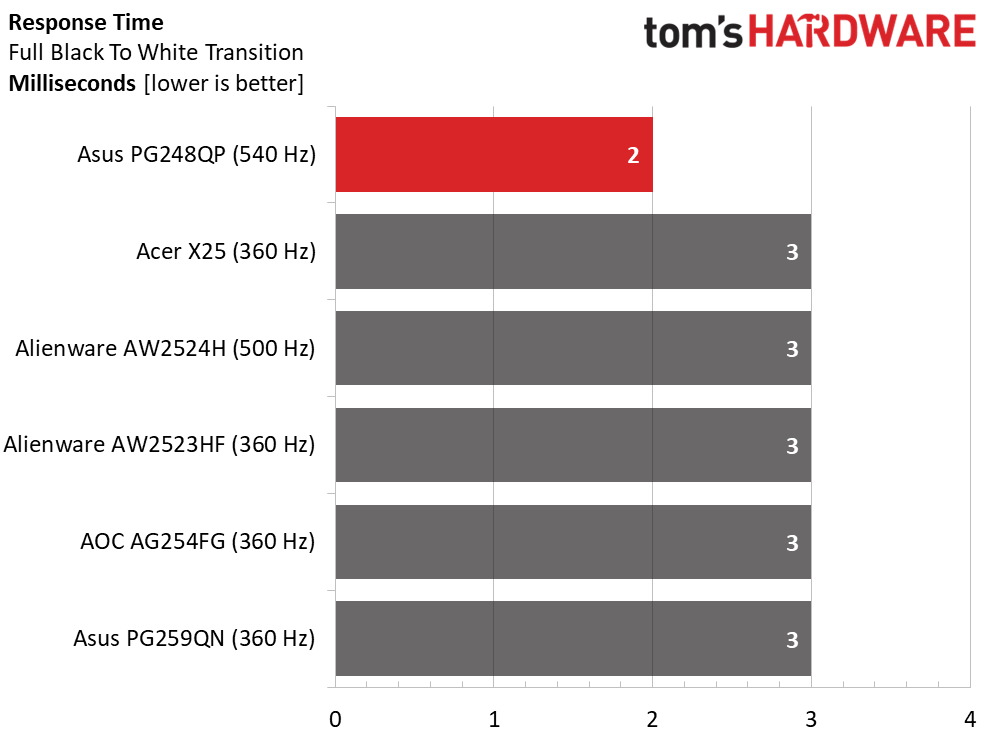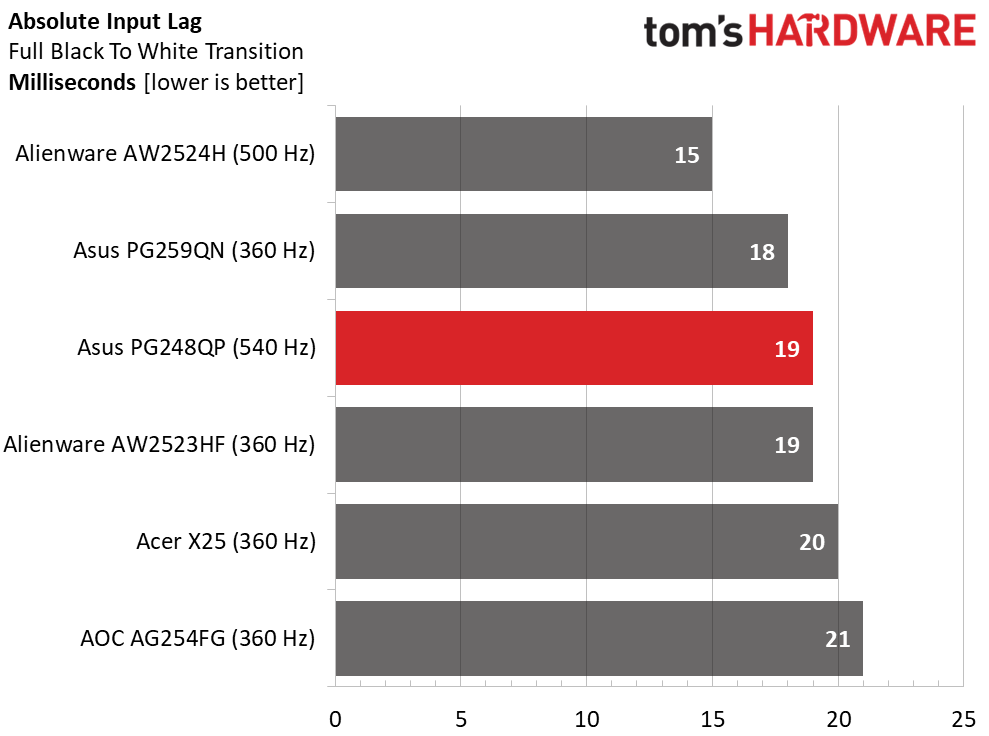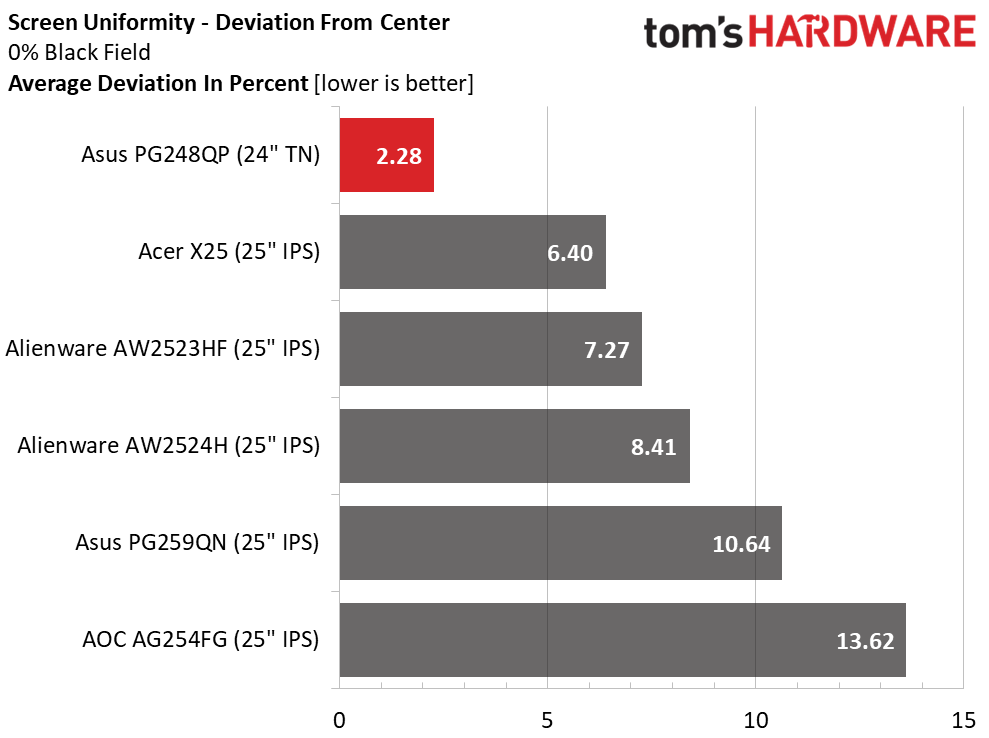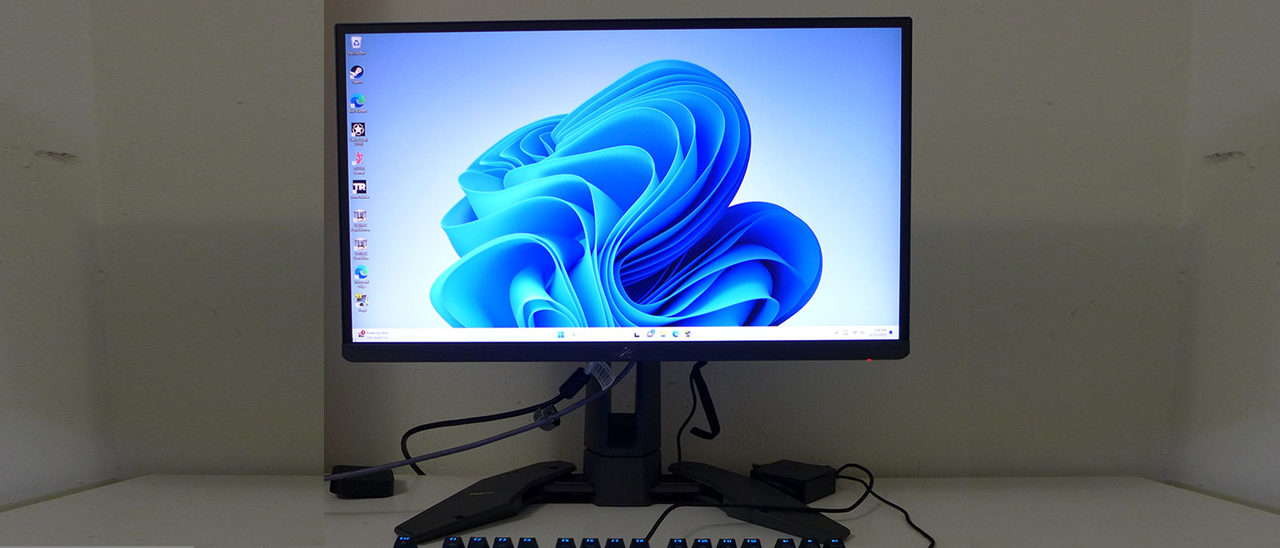Why you can trust Tom's Hardware
The PG248QP’s comparison group is all the speediest monitors in my database, 360 and 500 Hz. And yes, they all come from companies that start with the letter “A.” We have Alienware’s AW2542H and AW2523HF, AOC’s AG254FG, Acer’s X25 and Asus’ PG259QN. All are FHD, but only the PG248QP is TN.
Pixel Response and Input Lag
Click here to read up on our pixel response and input lag testing procedures.


I imagine many of you have skipped to this page so here we go. The PG248QP has the fastest panel response of any computer monitor I’ve ever tested at just 2ms. But wait, it doesn’t have the lowest input lag? That honor belongs to the AW2524H with its 15ms score. At 19ms, the PG248QP is roughly equal to a 360 Hz screen. Is this a scandal? Not if you consider what these scores mean. A 2ms panel response means high motion resolution. The PG248QP is super smooth with no visible loss of detail, no matter how fast the action moves on screen. You can whip the mouse like a Jedi; the image will never blur. The input lag score has more latitude. Differences of 5ms are imperceptible to all but the most skilled professional gamers. And visually, the smoother picture of the PG248QP will lend a competitive advantage more than a 4ms difference in input lag. Add ULMB 2 into the mix and it gets even better. Even the 240 Hz OLEDs I’ve tested can’t render as smoothly as the PG248QP.
Test Takeaway: If all you care about is input lag, get the Alienware AW2524H. But if you want the best-looking gaming monitor, and can maintain 500fps with your rig, the PG248QP is the only choice. Nothing is as smooth at 500fps or higher.
Viewing Angles

Given the TN panel in use here, I expected the PG248QP’s viewing angles to be poor. The photos don’t look that different from many VA screens I’ve reviewed and that’s a good thing. At 24 inches, it’s unlikely that sharing will be a consideration. It’s fine for a single user sitting on-center. At 45 degrees to the sides, the color shifts to green, but light output and gamma remain constant. You won’t see a reduction in picture detail. The top view is washed out and blue with 30% less brightness.
Screen Uniformity
To learn how we measure screen uniformity, click here.

My PG248QP sample had exceptional screen uniformity in the black field test, with one of the lowest scores I’ve ever recorded. There were no visible issues in any pattern or content during my review.
Get Tom's Hardware's best news and in-depth reviews, straight to your inbox.
MORE: Best Gaming Monitors
MORE: How We Test PC Monitors
MORE: How to Buy a PC Monitor
MORE: How to Choose the Best HDR Monitor
Current page: Response, Input Lag, Viewing Angles and Uniformity
Prev Page Features and Specifications Next Page Brightness and Contrast
Christian Eberle is a Contributing Editor for Tom's Hardware US. He's a veteran reviewer of A/V equipment, specializing in monitors. Christian began his obsession with tech when he built his first PC in 1991, a 286 running DOS 3.0 at a blazing 12MHz. In 2006, he undertook training from the Imaging Science Foundation in video calibration and testing and thus started a passion for precise imaging that persists to this day. He is also a professional musician with a degree from the New England Conservatory as a classical bassoonist which he used to good effect as a performer with the West Point Army Band from 1987 to 2013. He enjoys watching movies and listening to high-end audio in his custom-built home theater and can be seen riding trails near his home on a race-ready ICE VTX recumbent trike. Christian enjoys the endless summer in Florida where he lives with his wife and Chihuahua and plays with orchestras around the state.
-
javiindo Now you need to find a game you can play at 540 hz. Even with dlss3 it's not easy and to use dlss3 initroduce some latency .Reply -
The Historical Fidelity Not to be nit picky but color gamut is normally just a variable of back light and color filter quality. High Color Rendering Index leds emit a higher percentage of the visible light spectrum as well as higher light intensity in the areas of the visible spectrum that normal leds have a hard time producing in quantity (IE: deep reds, and cyan), and color filters can be made to inhibit color cross-talk and optimize polarization states, so I’m confused why sacrificing color gamut is typically correlated to high refresh rate when it does not affect refresh rate in any way?Reply -
helper800 If i cared about anything past 240hz, I would wait for a monitor such as the one talked about in this article. LG claims to have achieved 480hz OLED panels at 2560x1440. OLEDs motion clarity as a baseline has been the highest among panel technologies in my experience. My 120hz CX OLED from LG looks better in motion handling that my own 165hz IPS display from viewsonic. Th OLED CX also looks better, imo than my friends non-OLED 240hz samsung panel. If you are going to spend nearly 1000 dollars, imo its better to wait for a bigger leap in tech like the aforementioned LG panels.Reply -
Phaaze88 Folks already achieve ultra high fps on monitors that can't display it, so why should they spend money on products like this?Reply
/S -
UnforcedERROR Reply
This is a monitor almost exclusively for games like CS2 and Valorant, which aren't hard to run at high FPS. A 4090 at 1080p will get you 800 FPS in Valorant, for instance. A good CPU + GPU will get you the same in CS2 (Source engine is CPU-reliant). It's for the people who want to reduce input latency as low as possible, and it's a fairly niche space.javiindo said:Now you need to find a game you can play at 540 hz. Even with dlss3 it's not easy and to use dlss3 initroduce some latency .
That said, I think it's interesting this article credits the VG248 as the monitor that ushered in fast refresh monitors, considering the XL2420T beat it to market by a year, even if it was only 120hz. I'd argue that was the first real high refresh LCD monitor, and I remember it changing the competitive FPS landscape a lot at the time. -
Tom Sunday ReplyPhaaze88 said:Folks already achieve ultra high fps on monitors that can't display it, so why should they spend money on products like this?
I can appreciate the mentioning that video processing and speed here are on the next level. I only play three owned games, (Fallout 4, Dishonored and Wolfenstein New Order) will these at anything even close to the processing speed and image smoothness as advertised give me more of a real-live sensation and gaming WOW factor never experienced before? Like repairing the roads and roofs in Sanctuary faster and improving NPC fluidity? Of course true enthusiast gaming today is usually played on a 32-34 inch monitors for all the good reasons. Not customarily on a 24 inch screen! Then today what professional would do actual work on a 24-inch screen? Finally who would buy such monitor and then for almost a WTF $900? -
CmdrShepard This is the lamest and most deceptive review I ever read on Toms Hardware ever since the site was created.Reply
Why? Because it left out one of the most important tech spec items -- viewing angles.
Viewing Angle (CR≧10) : 170°/ 160°
TN panels are fast sure, but they are trash when it comes to viewing angles.
With 160 degrees vertical viewing angle you just need to slump in your chair a bit, and what you will see on the screen will no longer have any resemblance of the original color and contrast as when you were looking at it dead center at a 90 degrees angle.
Also, the claim is made in this "review" (more like a paid ad!) that this monitor covers over 89% of DCI P3 color space while the tech specs on ASUS website do not mention DCI P3 support anywhere -- they claim 125% sRGB which is a pure marketing garbage. 25% more than sRGB? in which direction on the color chart?. I checked the ICM profile using ICC Profile Inspector and it turns out only in R and G direction (B is well within sRGB if not a bit less) I doubt that monitor even has a DCI P3 color setting in the menu.
The author should be ashamed for writing such low quality content.
